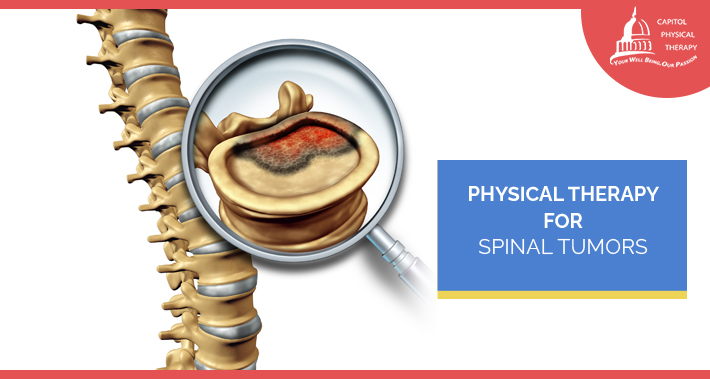
A spinal tumor diagnosis might feel stressful, but medical science has come a long way in treating them.
Today, people with spinal tumors can still go on to live long, healthy lives.
Some people with spinal tumors need surgery to remove the abnormal growths from their spine.
Spinal tumor surgery is considered a major surgery, and you’ll need post operative rehabilitation to get you feeling great once more.
But you’ll get there.
Here at Capitol Physical Therapy, we offer physical therapy for surgery recovery, including recovery from spinal tumor surgery.
In this article, we’ll highlight some of the major benefits of seeing a Washington DC physical therapist for recovery after spinal tumor surgery.
Keep reading to find out more.
What Is A Spinal Tumor?
Spinal tumors are abnormal growths located in or around your spinal column.
They are typically classified based on the type of tissue they are growing in and whether they are benign (noncancerous) or malignant (cancerous).
Let’s take a closer look at benign versus malignant spinal tumors.
Types Of Benign Spinal Tumors
Benign spinal tumors are noncancerous growths.
Nonetheless, benign tumors often still require surgical removal due to the risk of nerve or spinal cord damage.
Examples of benign spinal tumors include:
- Spinal osteochondroma – the most common type of benign bone tumor often found in your cervical spine located just below your skull
- Spinal hemangioma –develops from abnormal blood vessels and is typically symptom free
- Eosinophilic granuloma – a rare bone tumor more commonly found in children
- Osteoid osteoma – a type of non spreading bone tumor commonly found in long bones
- Spinal osteoblastoma – a rare bone tumor commonly diagnosed between in your 20s or 30s
- Spinal neurofibroma –develops within your spinal sensory nerves and is typically symptom free
- Aneurysmal bone cyst – a gradually growing blood filled tumor typically found pressed against the walls of your bones
- Giant cell tumor – a rare but aggressive type of benign tumor that can destroy the surrounding bones
- Meningiomas – a slow growing tumor typically found within the layers of tissue covering your brain and spinal cord
- Nerve sheath tumors – a benign and slow growing tumor often found within the protective layer wrapped around your nerves
Types Of Malignant Spinal Tumors
In contrast, malignant spinal tumors are cancerous growths.
Most types of malignant spinal tumors are the result of the spread of cancer from other organs in your body, like breast cancer.
These types of malignant tumors are referred to as metastases of organ cancer.
Most malignant spinal cord tumors are this type.
Tumors that start within your spinal cord are the rarest form of spinal tumors.
Examples of malignant spinal tumors include:
- Chordoma – a rare form of bone cancer commonly found near your tailbone
- Ewing’s sarcoma – a type of spinal tumor that develops in your spine or soft tissue surrounding your spine and is most commonly diagnosed in younger populations
- Osteosarcoma – another type of bone cancer that can spread to your spine. Most common in young children
- Multiple myeloma – a form of blood cancer that develops in your white blood cells and can spread tumors to many bones in your body, including your spine
- Glioma – a group of tumors that can develop in the supportive cells surrounding your nerves, your brain, or your spinal cord
Symptoms Of Spinal Cord Tumors
Many people living with spinal cord tumors experience no symptoms at all.
In other cases, pain is the first symptom of a spinal cord tumor.
The pain may gradually increase over time, be sharp or burning, get worse at night, and be noticeable even when resting.
RELATED: Physical Therapy For Chronic Pain
Tumors that are pressing against your nerve root commonly cause specific symptoms, such as:
- Muscle weakness
- Muscle numbness
- Tingling sensations
- Decreased ability to sense temperature, particularly in your legs
Less common symptoms of spinal cord tumors include:
- Urinary incontinence
- Bowel incontinence
- Sexual dysfunction
- Difficulty walking
Will You Need Spinal Cord Surgery?
This is a conversation to have with the physician in charge of your treatment.
Physical therapists aren’t involved in the surgery itself.
Your physician will be best able to guide you in your options when it comes to surgery.
How Can Physical Therapy After Spinal Surgery Help?
We get surgery because it’s the best long term option to improve our health.
But that doesn’t mean you’ll feel better right away.
Shortly after surgery, you’ll need to spend some time in physical rehabilitation.
Physical therapy after spinal surgery can help with your spinal alignment, balance, and general health.
This can help you recover more quickly and effectively.
Let’s take a look at some common methods used by physical therapists after spinal surgery.
1. Pain Management
Pain management is an important aspect of your recovery following a spinal cord surgery.
After all, it won’t be easy to participate in a physical therapy program if you’re in a significant amount of pain.
Physical therapy is geared toward helping you move your joints and muscles easily and effectively.
After your surgery, your physical therapist will use directed movements to relieve pressure, rebuild strength, and help you work toward recovery.
These movements will have the added effect of relieving your post surgical pain.

2. Strength And Stability Training
Your physical therapist will put together an individualized strength and stability training program that is specific to your unique needs.
Strength and stability training focuses on improving function in your muscles that have been weakened by a spinal tumor or surgery.
It may also include gait training physical therapy to help you walk effectively and painlessly.
3. Exercises To Promote Healing
Regular exercise is a vital component of your recovery following a spinal cord surgery.
How soon you’ll be able to return to certain activities, such as work or extensive physical activity, is highly dependent on how well your body responds to exercise after surgery.
In addition to promoting healing, exercises provided by physical therapists can reduce chronic fatigue and help you avoid reinjuring yourself.
Your physical therapist will put together an individualized exercise program that focuses on your specific needs and limitations.
4. Patient Education
Patient education is another important aspect of recovery following spinal cord surgery.
Your physical therapist will explain exactly what changes your body has experienced as a result of surgery and how you can maximize the surgery’s benefits.
Physical therapists have plenty of experience answering all sorts of questions regarding spinal tumors and surgery.
Therefore, your physical therapist will likely be able to answer any question you throw their way.
Book Your Appointment With Capitol Physical Therapy Today
At Capitol Physical Therapy, we pride ourselves on our dedication to helping people recover from major surgeries, such as spinal cord surgery.
A spinal tumor diagnosis can be stressful, but we’re here to help.
With the right treatment, many people with spinal tumors can still go on to live happy, healthy lives.
Book your appointment with Capitol Physical Therapy today to get started on your recovery.
1331 H St NW #200,
Washington, DC 20005
- https://g.page/capitolptdc
9560 Pennsylvania Ave. # 202,
Upper Marlboro, MD 20772
- https://goo.gl/maps/zjL4NnnuThRhrcS86
Capitol Physical Therapy offers orthopedic and other pain related solutions, with our versitile team of physical therapists in Washington, DC